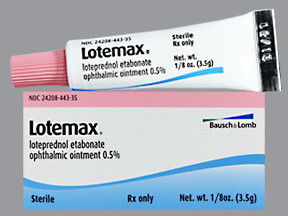LOTEPREDNOL OINTMENT - OPHTHALMIC
PHONETIC PRONUNCIATION: (LOE-te-PRED-nol)
COMMON BRAND NAME(S): Lotemax
GENERIC NAME(S): loteprednol etabonate
Uses
USES: This medication is used to treat eye inflammation and pain after eye surgery. Loteprednol works by relieving symptoms such as swelling, redness, and itching. It belongs to a class of drugs known as corticosteroids.
How to use LOTEPREDNOL OINTMENT - OPHTHALMIC
HOW TO USE: Do not wear contact lenses while you are using this medication. Sterilize contact lenses according to the manufacturer's directions, and check with your doctor before you begin using them again. To apply the eye ointment, wash your hands first. To avoid contamination, do not touch the tube tip or let it touch your eye or any other surface. Gently pull down the lower eyelid to make a pouch. Place a one-half inch (1.5 centimeter) strip of ointment into the pouch. Gently close the eye and roll the eyeball in all directions to spread the medication. Try not to blink or rub your eye. Repeat these steps for your other eye if so directed. Wipe the tip of the ointment tube with a clean tissue to remove extra medication before recapping it. If you are using another kind of eye medication (for example, drops or other ointments), wait at least 5 to 10 minutes before applying other medications. Use eye drops before eye ointments to allow the drops to enter the eye. Use this medication regularly to get the most benefit from it. To help you remember, use it at the same times each day. Apply as directed by your doctor, usually 4 times a day. The dosage and length of treatment are based on your medical condition and response to treatment. Do not use this medication more often or for longer than prescribed because doing so may increase your risk of side effects. Continue to use this medication for the full time prescribed. Do not stop using this medication without consulting your doctor. Some conditions may become worse when this drug is suddenly stopped. Your dose may need to be gradually decreased. Do not use this product if it becomes contaminated (for example, ointment turns a dark color or develops particles in it). Using contaminated eye medication can cause infection, serious damage to the eye, and loss of vision. Contact your doctor or pharmacist for more information. Tell your doctor if your condition does not improve after a few days or if it worsens.
Side Effects
Precautions
Interactions
Overdose
Images
Reviews
Faq for LOTEPREDNOL OINTMENT - OPHTHALMIC
- Loteprednol ointment is an ophthalmic medication used to treat inflammation and pain in the eyes caused by certain conditions, such as post-operative inflammation or allergic conjunctivitis.
- Loteprednol ointment contains a corticosteroid medication that works by reducing inflammation in the eyes. It inhibits the production of certain chemicals in the body that cause inflammation and pain.
- Wash your hands before applying the ointment. Tilt your head back, pull your lower eyelid downward to create a small pocket, and apply a small amount of ointment into the pocket. Close your eyes gently for about 1-2 minutes to allow the ointment to spread evenly. Avoid touching the tip of the tube to any surface, including your eyes. Use Loteprednol ointment exactly as prescribed by your doctor.
- Like any medication, Loteprednol ointment can cause side effects. Common side effects may include temporary stinging or burning sensation, blurred vision, itching, or redness in the eyes. If you experience severe or persistent side effects, contact your doctor immediately.
- Loteprednol ointment can be used in pediatric patients aged 6 months and older, but it should be used only as directed by a healthcare provider.
- If you miss a dose, apply it as soon as you remember. However, if it is almost time for your next scheduled dose, skip the missed dose and continue with your regular dosing schedule. Do not apply a double dose to make up for the missed one.
- Contact lenses should not be worn while using Loteprednol ointment. Discuss with your eye doctor whether it is safe to resume wearing contact lenses after completing the treatment.
- It is important to inform your doctor if you are pregnant, planning to become pregnant, or breastfeeding before using Loteprednol ointment. Your doctor will weigh the potential risks and benefits and determine if it is safe for you to use this medication.
- Loteprednol ointment should be stored at room temperature, away from moisture, heat, and direct light. Keep the tube tightly closed when not in use.
Common side effects of Loteprednol ointment include temporary burning or stinging in the eyes, blurred vision, increased sensitivity to light, and eye dryness or watering. Serious side effects are rare but can include eye infection or worsening of an existing infection.
The duration of treatment with Loteprednol ointment will be determined by your doctor based on the specific condition being treated. It is important to follow your doctor's instructions and not use the medication for longer than prescribed.
Certain medications, such as other corticosteroids or eye medications, may interact with Loteprednol ointment. It is important to inform your doctor or pharmacist about all the medications you are currently taking to avoid any potential interactions.
Disclaimer
IMPORTANT: HOW TO USE THIS INFORMATION: This is a summary and does NOT have all possible information about this product. This information does not assure that this product is safe, effective, or appropriate for you. This information is not individual medical advice and does not substitute for the advice of your health care professional. Always ask your health care professional for complete information about this product and your specific health needs.

No Reviews Yet